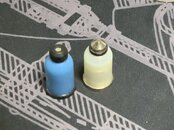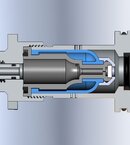Much like a contractor whose kitchen remodel is never quite complete, my gear is often the last in line for repair.
Both were heavily-used Jetstream second stages which required attention -- one from my day-to-day gear, and the other, part of the Atmosphere full face mask, the "PP" (positive pressure") version, which uses similar Xstream guts, and adds a "check valve," basically, a thin silicone gasket, to the top of the valve housing nut (#4951), for good measure.
While disassembling both second stages for the ultrasonic cleaner, I had forgotten that my Jetstream still had one of the older brass / silicone -- get this --"Niederdruckmanschette," or "low-pressure cuffs," (#3440) which most of the world still calls the damn thing.
The main difference between the older versus newer "second stage valve insert" was in its construction -- whether of a more conical brass model with a pinhole opening (seen right); or an extruded plastic of some form -- and the presence or lack of a sintered white filter at the hose end -- intended to further clean the breathing air of particulates. Both had similar silicone sheaths.
The older model never possessed any filter -- though I hadn't noticed any real differences between the two, and wondered whether anyone else with some of that older gear, had noticed anything?
Both were heavily-used Jetstream second stages which required attention -- one from my day-to-day gear, and the other, part of the Atmosphere full face mask, the "PP" (positive pressure") version, which uses similar Xstream guts, and adds a "check valve," basically, a thin silicone gasket, to the top of the valve housing nut (#4951), for good measure.
While disassembling both second stages for the ultrasonic cleaner, I had forgotten that my Jetstream still had one of the older brass / silicone -- get this --"Niederdruckmanschette," or "low-pressure cuffs," (#3440) which most of the world still calls the damn thing.
The main difference between the older versus newer "second stage valve insert" was in its construction -- whether of a more conical brass model with a pinhole opening (seen right); or an extruded plastic of some form -- and the presence or lack of a sintered white filter at the hose end -- intended to further clean the breathing air of particulates. Both had similar silicone sheaths.
The older model never possessed any filter -- though I hadn't noticed any real differences between the two, and wondered whether anyone else with some of that older gear, had noticed anything?






